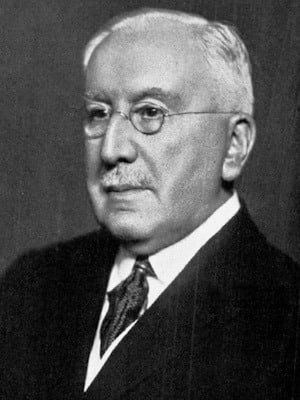Charles Ballance

Sir Charles Alfred Ballance (1856-1936) was an English surgeon.
Proposed a method for diagnosing splenic rupture; pioneer in neurotologic and skull base surgery; and first surgeon in history to perform a facial nerve crossover anastomosis in 1895
Ballance along with Sir William Macewen (1848-1924) led the way in establishing improved surgical treatment of suppurative disease in the middle ear and of its complications.
He worked closely with neurosurgeon Sir Victor Alexander Haden Horsley (1857-1916) and Charles A. Ballance (1856-1936) on problems of cerebral localisation, devising a novel method to identify cerebral vascular territory maps
Ballance’s (triad) sign (1898) for diagnosing splenic rupture in blunt abdominal trauma
Biography
- Born August 30, 1856 in Clapton, England
- 1881 – MBBS St. Thomas Medical School (gold medal in surgery)
- 1885 – FRCS Fellow of the Royal College of Surgeons
- 1906 – President of the Medical Society of London
- 1915 – Consultant surgeon to the British Army, stationed at Malta
- 1918 – KCMG; Knight Commander of the Order of St Michael and St George
- 1920 – Aural Surgeon to St. Thomas’ Hospital
- Vice-President of the Royal College of Surgeons
- 1926 – First president of the Society of British Neurological Surgeons; Chief Surgeon to the metropolitan police
- 1933 – Lister medal
- Died February 8, 1936
Medical Eponyms
Ballance (triad) sign (1898)
Ballance proposed a method for diagnosing splenic rupture in blunt abdominal trauma in particular fixed dullness to percussion in the left flank and shifting dullness to percussion in the right flank seen with splenic rupture/haematoma
…diagnosis of ruptured spleen is arrived at from:
- The locality of the injury.
- The evidence of internal haemorrhage; and
- The large fixed dulness in the left flank.
The fixed dulness in the left loin and splenic region is not present in intra-abdominal haemorrhage from other organs, and is caused by this region being occupied by large quantities of clot. The dulness, therefore, cannot change with position, and is pathognomonic of this injury. The unusually large proportion of white corpuscles in splenic venous blood offers an explanation of the local coagulation of the effused blood in splenic rupture. Further, the exceptional coagulability of the splenic blood offers an explanation of the fact that these patients do not rapidly bleed to death
Major Publications
- Ballance CA, Edmunds W. The ligation of the larger arteries in their continuity: an experimental inquiry. Medico-Chirurgical Transactions. 1886; LXIX: 1-30
- Sherrington CS, Ballance CA. On formation of scar tissue. Journal of physiology 1889; 10(6): 550-576
- Ballance CA, Shattock SG. A note on an experimental investigation into the pathology of cancer. Proceedings of the Royal Society. 1890; 48: 393-403
- Ballance CA, Edmunds W. A treatise on the ligation of the great arteries in continuity: with observations on the nature, progress and treatment of aneurism. 1891
- Ballance CA. On splenectomy for rupture without external wound. Practitioner. 1898; 60: 347-358.
- Ballance CA. The conduct of the mastoid operation for the cure of chronic purulent otorrhaea. Medico-Chirurgical transactions. 1900; 83: 1-33
- Ballance CA, Stewart P. The healing of nerves. 1901
- Ballance CA. A case of aneurysm involving the innominate, the right subclavian, and the right common carotid arteries. 1902
- Ballance CA, Ballance HA, Steward P. Remarks on the operative treatment of chronic facial palsy of peripheral origin. Br Med J 1903; 1: 1009-1013
- Ballance CA. Some points in the surgery of the brain and its membranes. 1907
- Ballance CA. A glimpse into the history of surgery of the brain In: Thomas Vicary Lecture. Lancet. 1922; 199(5134): 111-116
- Ballance CA. A glimpse into the history of surgery of the brain (Part II) In: Thomas Vicary Lecture. Lancet. 1922; 199(5135): 165 – 172
- Ballance CA, Duel AB. The operative treatment of facial palsy by the introduction of nerve grafts into the Fallopian canal and by other intratemporal methods. Arch Otolaryngol. 1932; 15(1): 1-70.
References
Biography
Eponymous terms
- Obituary: Charles Alfred Ballance, 1856-1936. Bull N Y Acad Med. 1936; 12(3): 146–149.
- Colledge L. Sir Charles Ballance 1856–1936. Annals of Otology, Rhinology & Laryngology. 1936; 45(4): 1186–1188
- Van de Graaf RC, Ljpma FFA, Nicolai J-P A. Sir Charles Alfred Ballance (1856–1936) and the introduction of facial nerve crossover anastomosis in 1895. Journal of Plastic, Reconstructive & Aesthetic Surgery, 2009; 62(1): 43–49
- Waldman EH, Lustig LR. Sir Charles Alfred Ballance: Contributions to Otology and Neurotology. Otol Neurotol. 2005; 26(5): 1073-82.
- Manché A. Sir Charles Ballance: A pioneer surgeon in Malta. Malta Medical Journal 2014; 26(3): 56-59
- Rastogi V et al. Abdominal Physical Signs and Medical Eponyms: Part I. Percussion, 1871–1900. Clin Med Res. 2020 Mar;18(1):42-47.
Eponym
the person behind the name
